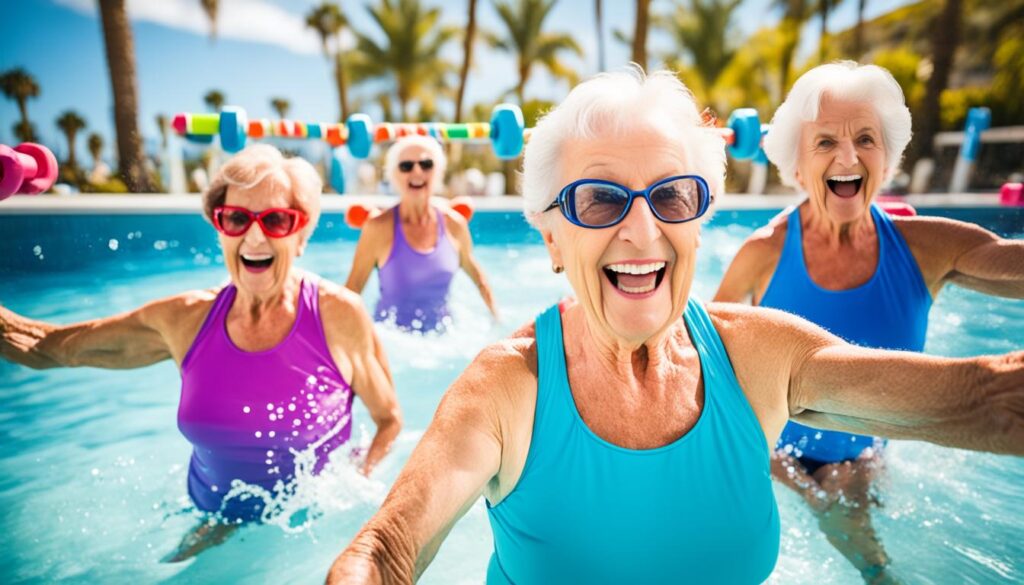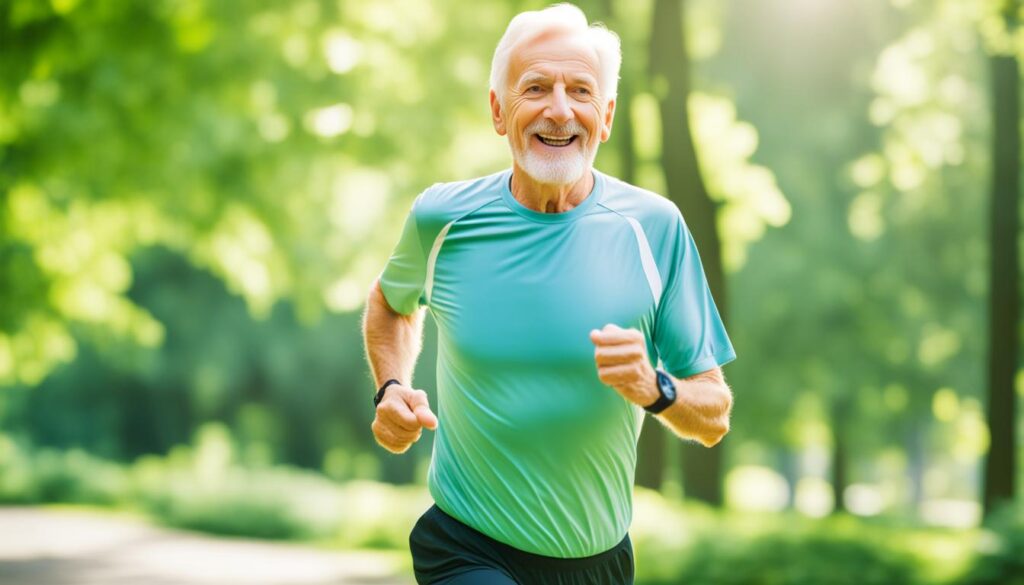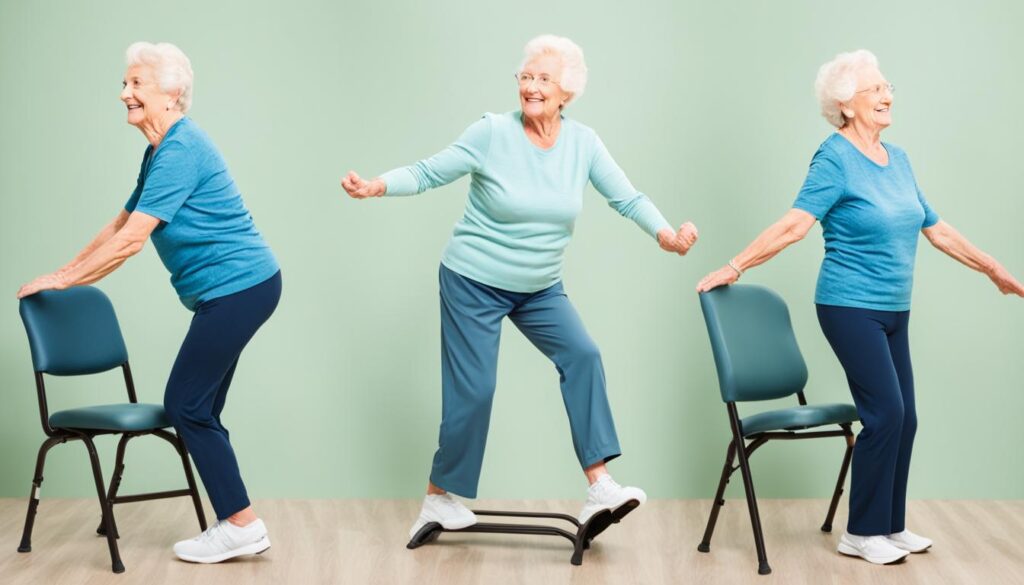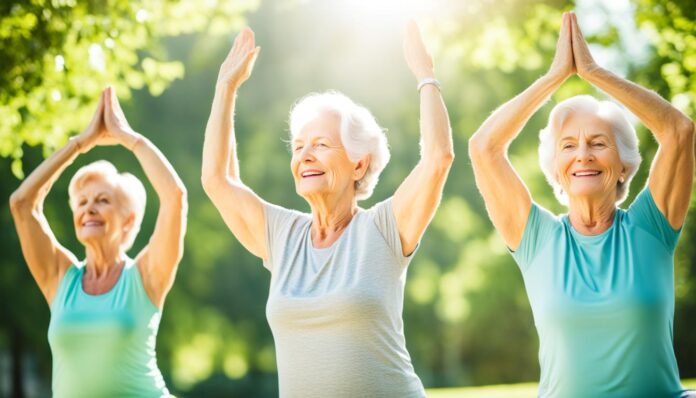As we age, maintaining an active lifestyle becomes increasingly crucial. But how can seniors stay fit and healthy? The answer lies in finding the right exercises to keep your body strong, flexible, and balanced. In this article, we’ll explore the top exercises that can help seniors stay fit and engaged.
What exercises are best for seniors to stay active and independent? The key is to focus on movements that improve strength, balance, and overall mobility. By incorporating a variety of exercises tailored to your needs, you can extend your lifespan, reduce the risk of falls, and enjoy a higher quality of life1.
Key Takeaways
- Regular exercise can lower the risk of chronic conditions and boost mental health in seniors.
- Endurance exercises, strength training, and balance exercises are crucial for maintaining independence.
- Simple exercises like walking, swimming, and chair yoga can be easily incorporated into daily routines.
- Consulting a healthcare provider is important before starting a new fitness program, especially for seniors with chronic conditions.
- Staying active and engaged can help seniors live longer, healthier, and more fulfilling lives.
Importance of Exercise for Seniors
Benefits of Regular Physical Activity
Physical activity is essential for seniors to maintain good mental health and prevent chronic diseases. It plays a pivotal role in maintaining and improving mental health, not just about building muscle or losing weight, but also taking care of the mind2. Seniors 65 and older should aim for at least 2.5 hours of moderate aerobic exercise per week2. Alternatively, seniors can opt for 1 hour and 15 minutes of vigorous exercise per week2. Strength training should be incorporated at least 2 days a week for seniors, and it is recommended to work on balance and flexibility daily2.
Regular physical activity can help prevent many common diseases, such as heart disease and diabetes3. Studies show that exercise improves overall immune function, critical for seniors with compromised immune systems3. Walking, even at a light intensity, plays a vital role in disease management3. Exercise produces endorphins, the “feel good” hormone, reducing stress and promoting happiness3. It also improves sleep quality, crucial for older adults struggling with insomnia3.
Exercise improves strength, flexibility, balance, and coordination, reducing the risk of falls for seniors3. Regular exercise decreases the time needed for recovery from falls in aging adults3. Social engagement through exercise helps combat loneliness and depression in seniors, enhancing their sense of purpose3. Physical activity benefits cognitive function and may lower the risk of dementia in physically active individuals3. Making exercise a priority and habit in daily life can lead to a range of health benefits for seniors3.
“Regular physical activity is crucial for older adults to maintain their health, independence, and quality of life as they age.”
In a study by Musich et al. (2017), it was found that physical activity frequency is positively associated with health benefits in older adults4. According to Dumith et al. (2011), physical inactivity prevalence worldwide is associated with the Human Development Index in 76 countries4. Peterson et al. (2011) conducted a meta-analysis and discovered that resistance exercise has a significant influence on lean body mass in aging adults4. A systematic review by Lopez et al. (2018) highlighted the benefits of resistance training in physically frail elderly individuals4.
A study by El-Khoury et al. (2013) evaluated the effects of fall prevention exercise programs on fall-induced injuries in community-dwelling older adults, showing positive outcomes4. Sherrington et al. (2017) updated a systematic review and meta-analysis on exercise to prevent falls in older adults, emphasizing the importance of physical activity in fall prevention4. Laukkanen et al. (2004) found that cardiorespiratory fitness is predictive of cardiovascular events in men with varying risk profiles4. Daly et al. (2015) established a bidirectional relationship between physical activity and executive function in older adults, showcasing the cognitive benefits of exercise4. Best et al. (2014) demonstrated that improvements in executive function during exercise training predict the maintenance of physical activity over the following year423.
Types of Exercises for Seniors
As we age, maintaining an active lifestyle becomes increasingly important to preserve our physical and cognitive health. The types of exercises suitable for seniors can be broadly categorized into several key areas: endurance, strength training, balance exercises, and flexibility5.
Endurance exercises, such as brisk walking, cycling, and swimming, are essential for improving cardiovascular health, reducing the risk of chronic diseases, and enhancing overall stamina5. These activities elevate the heart rate and breathing, allowing seniors to build their aerobic capacity and enjoy the numerous benefits of an active lifestyle.
Strength training exercises, which involve the use of weights, resistance bands, or bodyweight, play a crucial role in maintaining muscle mass, bone density, and overall strength as we age5. By engaging in activities like squats, lunges, and lifting weights, seniors can delay the effects of sarcopenia, the age-related loss of muscle mass, and improve their ability to perform daily tasks with ease.
Balance exercises are particularly important for seniors, as they help reduce the risk of falls and improve overall stability and coordination5. Activities like Tai Chi, standing on one leg, and practicing various balance drills can significantly enhance an older adult’s spatial awareness and reduce the likelihood of serious injuries from falls.
Flexibility exercises, such as stretching and yoga, are essential for maintaining range of motion, joint health, and overall mobility5. By incorporating targeted stretches for the shoulders, hips, and legs, seniors can improve their flexibility, reduce stiffness, and enhance their independence in daily living.
When designing an exercise program for seniors, it is recommended to include a combination of these different exercise categories to address the various aspects of physical health and well-being5. A well-rounded approach that combines endurance, strength, balance, and flexibility training can help seniors maintain their physical capabilities, reduce the risk of chronic conditions, and enjoy a higher quality of life as they age.
In addition to these primary exercise categories, seniors may also benefit from activities like dancing, which combines elements of endurance, strength, and balance, as well as low-impact exercises such as water aerobics, which provide a gentle yet effective workout5. The key is to find activities that align with an individual’s interests, abilities, and personal preferences, ensuring long-term adherence and enjoyment of the exercise routine.
Ultimately, the types of exercises for seniors should be tailored to their specific needs, physical abilities, and personal goals6. By incorporating a diverse range of exercises that target different aspects of physical fitness, seniors can maintain their independence, reduce the risk of falls and chronic diseases, and enjoy a healthier, more active lifestyle as they age567.
Walking: A Simple and Accessible Exercise
Walking is one of the easiest and most accessible exercises for seniors. It is a low-impact activity that can be enjoyed indoors or outdoors, alone or with a group. Regular walking has been shown to significantly improve cardiovascular health, increase endurance, and maintain a healthy weight among older adults8.
Benefits of Walking for Seniors
According to a study conducted in 2008 at the University of Georgia, engaging in regular walks can decrease the likelihood of developing a physical disability by 41% among elderly adults8. This allows them to maintain their independence and continue living in their own homes. Walking is an excellent form of low-impact exercise for seniors that can provide a wealth of health benefits.
- Improves cardiovascular health and reduces the risk of heart disease, stroke, and other chronic conditions9
- Helps maintain a healthy weight and aids in weight management9
- Increases muscular strength and endurance, preventing muscle loss and atrophy10
- Enhances balance and coordination, reducing the risk of falls10
- Boosts mood and mental well-being, alleviating symptoms of depression and anxiety8
The CDC recommends that adults aged 65 and older engage in at least 150 minutes of moderate-intensity walking per week, or 75 minutes of vigorous-intensity walking, to maintain overall health10. Walking is a simple, accessible, and versatile exercise that can be easily incorporated into the daily routines of seniors, making it an excellent choice for staying fit and active.
“Walking is one of the best exercises for seniors because it’s low-impact, requires no special equipment, and can be done almost anywhere.”
By making walking a regular part of their lifestyle, seniors can enjoy the numerous benefits of walking for seniors and maintain their physical independence and overall well-being8910.
Water Aerobics: Low-Impact Exercise
For seniors seeking a gentle, joint-friendly workout, water aerobics is an excellent choice. As a low-impact exercise, water aerobics allows older adults to engage in physical activity without the strain on their joints11. The buoyancy of water reduces pressure on bones and joints, positively impacting bone health for seniors12.
Water exercises are designed to be low-impact, reducing the risk of injury, pain, and stalling progress13. Seniors can enjoy exercises that are at least waist deep in water but not above shoulder height, ensuring a comfortable and safe experience13. The resistance provided by water can also help seniors gain muscle strength11, while the buoyancy can improve balance and flexibility12.
Some recommended water exercises for seniors include walking/jogging, marching in place, calf raises, chest fly, biceps curls, arm raises, wall push-ups, leg lifts (hip extension/flexion), leg lifts (hip abduction/adduction), hamstring curls, flutter kicks, and wall chair exercises11. These water-based activities target multiple muscle groups without straining the body, aiding in muscle strengthening, better balance, alleviating joint pain, and improving flexibility in seniors12.
Before starting any new exercise routine, seniors should consult with a physician to ensure the activities align with their health goals and physical capabilities11. Water exercises offer an opportunity for seniors to maintain an active lifestyle and promote mobility, while also providing a social environment for community building13.

By incorporating water aerobics into their fitness regimen, seniors can enjoy the benefits of a low-impact workout that caters to their unique needs and preferences111213.
| Benefits of Water Aerobics for Seniors |
|---|
| Low-impact on joints |
| Improved muscle strength |
| Enhanced balance and flexibility |
| Reduced risk of injury and pain |
| Positive impact on bone health |
| Opportunity for social interaction |
What are the best exercises for seniors to stay fit?
Best Exercises for Seniors
As we age, maintaining an active lifestyle becomes increasingly crucial for preserving our health and well-being. The best exercises for seniors are those that strike a balance between safety, effectiveness, and enjoyment. These activities target key areas such as strength, flexibility, balance, and aerobic fitness, ultimately helping older adults stay fit and independent14.
One of the top recommended exercises for seniors is walking. Walking is a simple, accessible, and low-impact activity that can provide numerous benefits, including improved cardiovascular health, increased endurance, and better balance15. Another excellent option is water aerobics, which offers a gentle, low-impact workout that can improve cardiovascular fitness, muscle strength, and flexibility, all while reducing the risk of joint strain14.
Strength training is also an essential component of a well-rounded exercise routine for seniors. Regularly engaging in strength-building activities can help improve overall health and longevity, maintain bone density, and reduce the risk of falls1416. Exercises such as squats, bicep curls, and wall push-ups are excellent choices for seniors looking to build and maintain muscle strength14.
Yoga and Tai Chi are also highly recommended for older adults, as they combine gentle movements, balance training, and mental focus to improve flexibility, stability, and overall well-being15. Chair yoga, in particular, is an accessible option for seniors who may have mobility limitations or balance concerns.
When it comes to the best exercises for seniors, the key is to find activities that are enjoyable, challenging, and safe. By incorporating a variety of exercises that target different aspects of fitness, older adults can improve their physical and mental health, maintain their independence, and enhance their overall quality of life1615.
“Regular physical activity is one of the most important things older adults can do to maintain their health.” – Centers for Disease Control and Prevention
Exercises to Avoid for Seniors
As we age, our bodies undergo various changes, including reductions in flexibility, muscular strength, bone density, and recovery time from injuries17. To maintain an active and healthy lifestyle, it’s crucial for seniors to be mindful of exercises that may pose risks or be inappropriate for their age group.
High-impact exercises, such as running and jumping, can put excessive strain on the joints and increase the risk of injury for older adults17. Exercises that require a lot of bending, twisting, or sudden movements can also be problematic, as they can stress the joints and muscles17. Seniors should also be cautious with exercises that require a significant amount of weight-bearing, as this can lead to joint and muscle strain.
- Leg extension machines can put unnecessary stress on the knee cap area for individuals over 5017.
- Back extensions on a Roman chair might be problematic for those with lower back instability or spinal cord narrowing17.
- Behind-the-neck pull-downs or pull-ups can stress the front of the shoulders, leading to potential injuries for older adults17.
- Plyometric exercises, if not done correctly or if one lacks sufficient muscle strength, can pose problems17.
- Overhead presses can place stress on the shoulders and rotator cuffs, common areas for injuries in individuals over 5017.
While it’s essential for seniors to engage in physical activity, they should prioritize low-impact exercises that are gentle on the joints17. Alternatives such as walking, water aerobics, and modified yoga and Pilates can provide a safe and effective workout for older adults17.
| Exercises to Avoid for Seniors | Safer Alternatives |
|---|---|
| High-impact exercises (e.g., running, jumping) | Walking, water aerobics, modified yoga and Pilates |
| Exercises with a lot of bending, twisting, or sudden movements | Low-impact, gentle exercises |
| Exercises with significant weight-bearing | Resistance training with light weights or resistance bands |
By avoiding high-impact, risky physical activities and opting for safer, low-impact alternatives, seniors can maintain an active lifestyle while minimizing the risk of injury and promoting overall health and well-being171819.
“Staying active and engaged is crucial for seniors, but it’s important to choose exercises that are appropriate for their age and physical abilities.”
Safety Tips for Seniors Exercising
Precautions for Safe Exercise
As seniors embrace an active lifestyle, prioritizing safety is paramount. Before starting any exercise program, it’s crucial to consult with a healthcare professional to ensure the routine aligns with one’s health needs and limitations20. Incorporating all four types of exercises – endurance, strength, balance, and flexibility – can help seniors maintain a well-rounded fitness regimen20.
When embarking on an exercise journey, seniors should take the time to warm up and cool down properly to prevent injury20. Using the right equipment, such as supportive shoes and assistive devices, can also enhance safety and stability during physical activities20. Seniors should start slowly and gradually increase the intensity and duration of their workouts, listening to their bodies and adjusting as needed20.
Maintaining an active social network can further enhance the safety and enjoyment of exercise for older adults20. Joining local fitness classes or community groups can provide a supportive environment and motivation to stay consistent with exercise routines20. Utilizing available resources, such as community centers or outdoor spaces, can also facilitate ongoing physical activity for seniors20.
While life events or changes in health conditions may disrupt exercise routines, it’s important for seniors to adapt and resume physical activity gradually20. Incorporating short bursts of activity throughout the day can be just as effective as dedicated exercise sessions, helping seniors meet their fitness goals20.
By following these safety tips and taking precautions, seniors can enjoy the numerous benefits of exercise while minimizing the risk of injury or discomfort20. Consistent physical activity can enhance seniors’ overall health, improve balance and reduce the risk of falls, and even lower the chances of developing Alzheimer’s disease or dementia21.
Endurance Exercises for Seniors
Maintaining endurance, or cardiovascular fitness, is crucial for seniors to stay active and independent. Endurance exercises such as brisk walking, swimming, and cycling can improve heart and lung function, reducing the risk of chronic diseases like heart disease and type 2 diabetes22. As we age, endurance exercises can even help reverse the effects of aging on the body’s metabolism and cardiovascular capacity22.
Endurance activities not only benefit the heart and lungs but also improve muscular endurance, which is essential for maintaining strength, stability, and mobility in older adults22. Exercises like pushups, planks, and squats can help build muscular endurance, leading to better posture, core stability, and the ability to perform daily tasks with ease22.
When it comes to endurance exercises for seniors, low-impact activities like swimming and indoor cycling are great options. These workouts provide cardiovascular and muscular endurance benefits without putting excessive stress on the joints22. Walking is another excellent choice, as it can decrease the risk of developing chronic conditions, maintain a healthy weight, boost mood, and improve bone density2223.
For optimal endurance benefits, seniors should aim to perform these activities for at least 2-3 times per week, with a recommended heart rate range of 65% to 80% of their maximum heart rate23. The Rate of Perceived Exertion scale and the Talk Test method can also help seniors gauge the intensity of their workouts23.
Incorporating a variety of endurance exercises, along with strength, balance, and flexibility training, can significantly improve overall health and physical ability in older adults24. By staying active and engaging in regular cardiovascular activities, seniors can maintain their independence, reduce the risk of chronic diseases, and enjoy a better quality of life24.

“Endurance exercise can shield metabolism from aging effects and improve cardiovascular capacity, even reversing the impact of 30 years of aging on middle-aged men.” – Harvard Health Publishing
Strength Training for Seniors
Strength training, also known as resistance exercises, is a crucial component of a well-rounded fitness routine for seniors. These exercises involve using weights, resistance bands, or bodyweight to challenge and strengthen the muscles. By engaging in strength training, older adults can maintain muscle mass, increase bone density, and improve balance and posture – all of which are essential for preserving independence and quality of life25.
The Centers for Disease Control and Prevention recommends that older adults should engage in strength training at least twice a week25. As a starting point, seniors are encouraged to perform three sets of 10 to 15 repetitions of basic bodyweight movements such as squats, lunges, and push-ups25. When transitioning to using light dumbbells or resistance bands, it’s advisable to start with the lightest weights available and gradually increase the resistance as your strength improves25.
One-on-one training sessions with a personal trainer are highly recommended for individuals of any age or fitness level to perfect their form and ensure they are performing the exercises correctly25. Proper form is crucial in strength training to maximize the benefits and prevent injury.
| Strength Training Workout for Seniors |
|---|
| Total Time: 25 minutes (5-minute warm-up, 15 minutes strength training, 5-minute cool-down) |
| Equipment Needed: Dumbbells or handheld weights (3 to 5 pounds to start, 8 to 10 pounds as you get stronger) |
| Repetition Range: 8 to 12 per side (varies for each exercise) |
| Core Exercises Repetition Range: 8 to 12 |
| Rest Time Between Exercises: 1 minute |
| Push-Ups Recommended: 8 to 12 total |
| Total Body Stretches Repetition Range: 8 to 10 |
Public health guidelines recommend performing resistance training exercises for the major muscle groups in the upper and lower body at least 2 days a week for seniors26. These exercises can include:
- Chest press or bench press to target the pectoralis major muscle, which is key for upper limb strength and essential for daily activities in seniors26.
- Shoulder press to target the deltoid muscle, important for arm abduction, a vital movement in day-to-day activities for seniors26.
- Squats to strengthen the muscles in the lower body, such as the quads, glutes, hamstrings, and calves26.
- Hip abduction exercises to target the glut medius muscle, which is crucial for balance and preventing knee pain and osteoarthritis in seniors26.
- Plank exercises to improve trunk strength, helping to stabilize the body during movements of the upper and lower limbs26.
- Deadlifts to target the gluteus maximus muscle, which is essential for hip extension and maintaining posture and balance in seniors26.
Multi-joint exercises that engage multiple muscle groups simultaneously, such as squats, deadlifts, chest press, rows, lat pull downs, and shoulder press, are highly recommended for seniors to maximize the benefits of their strength training26.
“Strength training is a game-changer for seniors, helping them maintain independence and improve their quality of life. It’s never too late to start building muscle and improving overall fitness.”
By incorporating strength training into their exercise routine, seniors can enjoy a range of benefits, from increased muscle mass and bone density to improved balance and posture. With the right guidance and a focus on proper form, strength training can be a safe and effective way for older adults to stay fit and active252726.
Balance Exercises for Seniors
Maintaining good balance is crucial for older adults to prevent falls and stay active. Balance exercises not only improve stability and coordination but also enhance posture and reduce the risk of accidents. Incorporating regular balance-focused activities into your routine can be a game-changer for seniors looking to stay fit and independent.
Activities to Improve Balance
From simple standing exercises to more challenging movements, there are various activities that can help seniors improve their balance. Some of the best balance exercises for older adults include:
- Standing on one foot: Holding this position for up to 30 seconds can significantly enhance balance and stability28.
- Heel-to-toe walking: Placing one foot directly in front of the other, like walking on a tightrope, engages the core muscles and improves balance28.
- Lunges: Taking steps forward or backward can help regain balance and improve lower-body strength. Aim for 5 to 10 lunges per leg28.
- Flamingo Stand: Lifting one leg off the ground and holding the position can be a challenging but effective balance exercise. Increase the difficulty by raising the leg higher or moving faster28.
- Tai Chi and Yoga: These gentle, mindful exercises focus on improving balance, flexibility, and posture, making them excellent choices for seniors29.
To see the best results, aim to perform these balance exercises at least three times per week, with each exercise repeated 3 to 5 times28.
Improving balance is crucial for older adults, as it can help prevent falls and maintain independence29. According to a study from 2016, older adults who engaged in a regular balance exercise program showed improved ability to move unassisted28. Balance exercises are also essential for fall prevention, as 1 in 4 adults aged 65 or older falls every year due to balance issues29.

By incorporating balance-focused activities into their daily routine, seniors can improve their overall physical function, cognitive abilities, and quality of life29. So, take the first step towards a more stable and secure future by exploring the best balance exercises for older adults.
Flexibility Exercises for Seniors
Maintaining flexibility is crucial for older adults to stay active and mobile. Flexibility exercises, such as stretching, can improve range of motion, reduce stiffness, and ease joint pain for seniors30. Approximately 87% of older adults can significantly benefit from regular movement and dynamic stretching to improve joint and muscle health30. These exercises can also help prevent falls by enhancing balance and strength31.
Stretching exercises for seniors can be done at any time of day, but it’s recommended to perform them in the mornings or evenings, especially for less mobile individuals31. Seniors should focus on stretching the lower extremities, such as the calves, hamstrings, hip flexors, and quadriceps, as these muscle groups become less elastic with age31.
Some effective flexibility exercises for seniors include:
- Standing quadriceps stretch: Balancing on one leg, gently pull the opposite heel towards the buttock to stretch the quadriceps31.
- Seated knee to chest: Sit up tall, hug one knee to the chest, feeling the stretch in the hip and lower back31.
- Hamstring stretch: Sit with one leg extended, gently hinge forward at the hips to stretch the back of the thigh31.
- Soleus stretch: Stand with one foot behind the other, keeping both heels on the ground, and lean into the wall or a chair to feel the stretch in the calf31.
- Overhead side stretch: Reach one arm overhead, gently leaning to the opposite side to stretch the abdomen, back, and shoulders31.
- Shoulder stretch: Bring one arm across the chest, using the other arm to gently pull the elbow towards the body, feeling the stretch in the shoulder31.
Performing each stretch for 10 to 30 seconds and repeating up to three rounds can help improve flexibility and mobility for seniors32. Safety is crucial, and seniors experiencing pain should consult a doctor or physical therapist before starting any new exercise routine32.
Incorporating flexibility exercises into a senior’s fitness routine can enhance overall physical function and independence303132. By maintaining range of motion and flexibility, older adults can continue to enjoy an active and engaged lifestyle.
Chair Yoga for Seniors
Chair yoga is a modified form of yoga that can be done in a chair or with the support of a chair. It is an excellent option for seniors with limited mobility or balance issues. Chair yoga can improve flexibility, strength, and reduce stress levels, making it a safe and accessible exercise option for older adults.
Approximately 35% of adults over the age of 70 experience mobility issues that can make a traditional yoga practice out of reach33. However, chair yoga provides a solution, allowing seniors to reap the benefits of yoga without the need for extensive movement or balance. Studies have shown that yoga can be as effective as traditional strength training for improving functional fitness among older adults33. Furthermore, chair yoga may help treat chronic conditions like heart disease, stroke, and chronic obstructive pulmonary disease (COPD), as well as alleviate symptoms of fibromyalgia, low back pain, and neck pain33.
The benefits of chair yoga for seniors are well-documented. A study of 35 older women in community care found that 12 weeks of chair yoga improved strength in the hands, arms, and legs34. Another study with 85 Taiwanese women with knee osteoarthritis found that regular chair yoga improved functional fitness34. Additionally, a 2016 study found that an 8-week chair yoga program reduced joint pain in older adults with osteoarthritis34. A 2012 study with a median age of 88 years found that 8 weeks of chair yoga improved mobility and decreased fear of falls among older adults34. A 2019 systematic review concluded that yoga can benefit physical strength, flexibility, and mental well-being in older adults34.
Chair yoga is a versatile and accessible exercise option for seniors. It can be tailored to individual needs and abilities, making it a safe and enjoyable way for older adults to stay active and improve their overall health and well-being35.
“Yoga has been shown to be as good as traditional strength training for improving functional fitness.”33
In conclusion, chair yoga is a valuable tool for seniors looking to stay active and improve their physical and mental well-being. With its low-impact nature and adaptability, chair yoga can be a game-changer for older adults who may have limited mobility or balance issues. By incorporating chair yoga into their routine, seniors can experience the numerous benefits of this practice, including increased strength, flexibility, and reduced stress levels35.
Pilates for Seniors
Pilates has become a popular form of exercise for seniors due to its low-impact nature. Pilates exercises are designed to increase endurance, muscle strength, balance, and posture. Research has found that Pilates can be beneficial for, with increased energy, decreased aches and pains, and greater confidence while moving36. Pilates is also low impact, making it ideal for seniors, as it can be performed in non-weight-bearing positions36.
Benefits of Pilates for Older Adults
Pilates can be integrated into rehabilitation for seniors after surgical procedures like hip replacement or knee surgery36. The exercises focus on building a strong core and stability, gradually increasing range of motion36. Pilates also uses breathing patterns to control exercises, promoting deep inhales and exhales for stress reduction36. Additionally, Pilates promotes increased flexibility, range of motion, and smoother movements, benefiting joints and muscle imbalances36. Pilates can also help with age-related ailments like arthritis by decreasing joint compression and maintaining motion range36.
Studies suggest that Pilates may enhance balance and through specific training and strengthening exercises targeting the trunk, hips, legs, and ankles37. Pilates has also been associated with improvements in mobility by offering a balanced approach to strength and flexibility, promoting better range of motion at the joints37. Furthermore, research indicates that Pilates decreases stress and enhances mood by combining mindful movement with breathing techniques37.
Women over 65 who did one-hour Pilates sessions three times per week improved their strength, balance, and reaction after 12 weeks compared to those who did not practice Pilates38. Beginners are recommended to practice Pilates at least twice a week, potentially increasing frequency for enhanced effectiveness36.
Pilates exercises for seniors include forearm plank, bird dog, seated twist reach, pelvic curl, single leg stretch, swimming, mountain climber, and teaser36. These exercises can also be adapted for seniors with limited balance or mobility by being performed in a chair38.
“Pilates has been shown to improve bone density, particularly among postmenopausal women.”37
Before beginning a Pilates program, older adults should consult a doctor and may benefit from one-on-one sessions or specialized group classes tailored for their age group37. Weight-bearing Pilates exercises, such as standing Pilates or resistance training on specialized equipment, can be beneficial for individuals with osteoporosis in building bone density and reducing fall and fracture risk37.
Incorporating Pilates into a senior’s exercise routine can provide a range of benefits, from improved strength and balance to enhanced mood and mobility. By embracing this low-impact form of exercise, seniors can stay active and maintain their independence while enjoying the numerous advantages Pilates has to offer363738.,,
Conclusion
Maintaining an active lifestyle is integral to a healthy and fulfilling senior lifestyle. The best exercises for seniors are those that balance safety, effectiveness, and enjoyment, while targeting key areas such as strength, flexibility, balance, and aerobic fitness39.
Activities like walking, water aerobics, yoga, Pilates, and chair exercises are excellent options that can help seniors stay fit and independent394041. By incorporating a variety of exercises tailored to their abilities and preferences, seniors can enjoy the countless physical and mental health benefits of regular physical activity3940.
Staying active as a senior, with a focus on exercise for older adults, can lead to a summary of improved cardiovascular health, increased muscle mass and bone density, better balance and coordination, reduced risk of chronic diseases, and enhanced mental well-being394041. By prioritizing senior fitness, older adults can maintain their independence, quality of life, and embrace a fulfilling and vibrant golden years.
FAQ
What are the benefits of regular exercise for seniors?
Regular exercise can help seniors extend their lifespan, maintain their ability to live independently, reduce the risk of falling, keep bones and muscles healthy, improve muscle strength, and reduce anxiety and depression.
What are the main categories of exercises for seniors?
The main categories of exercises for seniors include endurance, strength training, balance exercises, and flexibility exercises.
What are some of the best exercises for seniors to stay fit and active?
Some of the best exercises for seniors include walking, water aerobics, cycling, yoga, resistance band exercises, chair yoga, and tai chi.
What exercises should seniors avoid?
Seniors should avoid high-impact exercises like running and jumping, exercises that require a lot of bending or twisting, exercises that require a lot of jumping, and exercises that require quick and sudden movements.
What are the safety tips for seniors exercising?
Key safety tips for seniors exercising include consulting a doctor before starting any exercise program, warming up and cooling down, using proper equipment, starting slow and gradually increasing intensity, and listening to your body.
What are the benefits of endurance exercises for seniors?
Endurance exercises, such as walking, water aerobics, and cycling, can improve cardiovascular health, increase endurance, and reduce the risk of chronic diseases for seniors.
How can strength training benefit seniors?
Strength training exercises, such as using resistance bands or performing bodyweight exercises, can help seniors maintain muscle mass, increase bone density, and improve balance and posture.
What are the benefits of balance exercises for seniors?
Balance exercises, such as standing on one foot or using a stability ball, can help seniors maintain their balance, improve stability and coordination, and reduce the risk of falls.
How can flexibility exercises benefit seniors?
Flexibility exercises, such as stretching and Pilates, can increase mobility, reduce stiffness, and improve posture for seniors.
What are the benefits of chair yoga for seniors?
Chair yoga is a modified form of yoga that can improve flexibility, strength, and reduce stress levels, making it a safe and accessible exercise option for seniors with limited mobility or balance issues.
How can Pilates benefit older adults?
Pilates exercises can increase endurance and muscle strength, improve balance and posture, and decrease the risk of falling for seniors.
Source Links
- Best Exercises for Senior Citizens
- Exercise and Seniors – familydoctor.org
- 5 Benefits of Exercise for Seniors and Aging Adults | The GreenFields
- The Importance of Physical Activity Exercise among Older People
- A Guide To The Best Exercises For Seniors
- Physical activity guidelines for older adults
- The #1 Exercise to Do as You Get Older
- Fun Ways for Older Adults to Stay Physically Active
- How to Exercise with Limited Mobility – HelpGuide.org
- 3 Exercises for Seniors to Do Anywhere | eliseo
- 12 Water Aerobic Exercises for Seniors
- 11 Simple Water Exercises for Seniors
- 10 Pool Exercises for Seniors | Harbour’s Edge
- Total Body Strength Workout for Seniors Builds Stability
- Senior Exercise and Fitness Tips – HelpGuide.org
- Growing Stronger – Strength Training for Older Adults
- Exercises to Avoid After 50
- What Exercises Should Seniors Avoid? | Brooklyn Park
- 7 Worst Exercises that Seniors Should Avoid – SilverSneakers
- Staying Motivated to Exercise: Tips for Older Adults
- Staying Fit After Fifty: The Best Exercises for Older Adults – Harrison Senior Living
- The 6 Endurance Exercises You Should Be Doing After 60
- How to Improve Your Elderly Endurance
- Exercise for Older Adults: MedlinePlus
- 5 Strength Training Exercises for Seniors – SilverSneakers
- What are the Best Resistance Training Exercises For Older Adults? – Keeping Strong
- Strength Training for Seniors? Try Our Workout
- Best Balance Exercises for Seniors
- The 8 Best Balance Exercises for Seniors – GoodRx
- Best Dynamic Stretches for Older Adults
- 9 Stretching Exercises for Seniors
- 7 Simple Stretches for Older Adults
- Chair Yoga Exercises for Seniors: 10 Poses and Tips to Get You Started – GoodRx
- Chair yoga for seniors: Benefits and poses for beginners
- Chair yoga for seniors: All the benefits and how to get started
- 8 Pilates Exercises to Help Improve Senior Health
- Pilates for Seniors: Benefits, Considerations, and More
- Pilates for Seniors: Core Workout You Can Do At-Home – SilverSneakers
- Best Exercises for Seniors | Live Oak Fitness
- Exercises for Elderly: 3 types to improve their physical health
- Top 7 Exercises for Senior Citizens – Age With Grace



